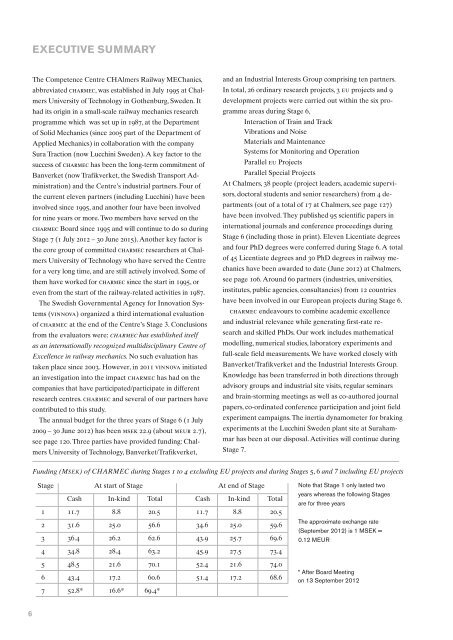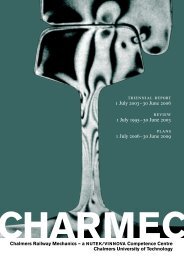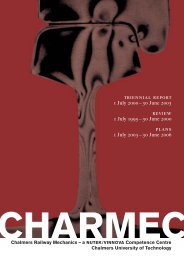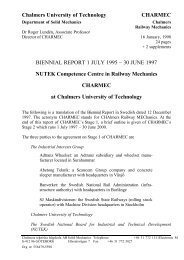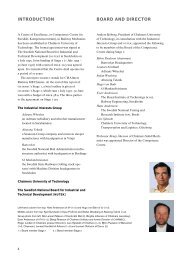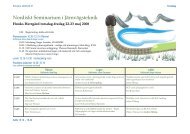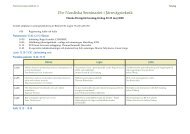stage 6 triennial report 1 July 2009–30 June 2012 ... - CHARMEC
stage 6 triennial report 1 July 2009–30 June 2012 ... - CHARMEC
stage 6 triennial report 1 July 2009–30 June 2012 ... - CHARMEC
You also want an ePaper? Increase the reach of your titles
YUMPU automatically turns print PDFs into web optimized ePapers that Google loves.
6<br />
EXECUTIVE SUMMARY<br />
The Competence Centre CHAlmers Railway MEChanics,<br />
abbreviated charmec, was established in <strong>July</strong> 1995 at Chalmers<br />
University of Technology in Gothenburg, Sweden. It<br />
had its origin in a small-scale railway mechanics research<br />
programme which was set up in 1987, at the Department<br />
of Solid Mechanics (since 2005 part of the Department of<br />
Applied Mechanics) in collaboration with the company<br />
Sura Traction (now Lucchini Sweden). A key factor to the<br />
success of charmec has been the long-term commitment of<br />
Banverket (now Trafikverket, the Swedish Transport Administration)<br />
and the Centre’s industrial partners. Four of<br />
the current eleven partners (including Lucchini) have been<br />
involved since 1995, and another four have been involved<br />
for nine years or more. Two members have served on the<br />
charmec Board since 1995 and will continue to do so during<br />
Stage 7 (1 <strong>July</strong> <strong>2012</strong> – 30 <strong>June</strong> 2015). Another key factor is<br />
the core group of committed charmec researchers at Chalmers<br />
University of Technology who have served the Centre<br />
for a very long time, and are still actively involved. Some of<br />
them have worked for charmec since the start in 1995, or<br />
even from the start of the railway-related activities in 1987.<br />
The Swedish Governmental Agency for Innovation Systems<br />
(vinnova) organized a third international evaluation<br />
of charmec at the end of the Centre’s Stage 3. Conclusions<br />
from the evaluators were: charmec has established itself<br />
as an internationally recognized multidisciplinary Centre of<br />
Excellence in railway mechanics. No such evaluation has<br />
taken place since 2003. However, in 2011 vinnova initiated<br />
an investigation into the impact charmec has had on the<br />
companies that have participated/participate in different<br />
research centres. charmec and several of our partners have<br />
contributed to this study.<br />
The annual budget for the three years of Stage 6 (1 <strong>July</strong><br />
2009 – 30 <strong>June</strong> <strong>2012</strong>) has been msek 22.9 (about meur 2.7),<br />
see page 120. Three parties have provided funding: Chalmers<br />
University of Technology, Banverket/Trafikverket,<br />
and an Industrial Interests Group comprising ten partners.<br />
In total, 26 ordinary research projects, 3 eu projects and 9<br />
development projects were carried out within the six programme<br />
areas during Stage 6,<br />
Interaction of Train and Track<br />
Vibrations and Noise<br />
Materials and Maintenance<br />
Systems for Monitoring and Operation<br />
Parallel eu Projects<br />
Parallel Special Projects<br />
At Chalmers, 38 people (project leaders, academic supervisors,<br />
doctoral students and senior researchers) from 4 departments<br />
(out of a total of 17 at Chalmers, see page 127)<br />
have been involved. They published 95 scientific papers in<br />
international journals and conference proceedings during<br />
Stage 6 (including those in print). Eleven Licentiate degrees<br />
and four PhD degrees were conferred during Stage 6. A total<br />
of 45 Licentiate degrees and 30 PhD degrees in railway mechanics<br />
have been awarded to date (<strong>June</strong> <strong>2012</strong>) at Chalmers,<br />
see page 106. Around 60 partners (industries, universities,<br />
institutes, public agencies, consultancies) from 12 countries<br />
have been involved in our European projects during Stage 6.<br />
charmec endeavours to combine academic excellence<br />
and industrial relevance while generating first-rate research<br />
and skilled PhDs. Our work includes mathematical<br />
modelling, numerical studies, laboratory experiments and<br />
full-scale field measurements. We have worked closely with<br />
Banverket/Trafikverket and the Industrial Interests Group.<br />
Knowledge has been transferred in both directions through<br />
advisory groups and industrial site visits, regular seminars<br />
and brain-storming meetings as well as co-authored journal<br />
papers, co-ordinated conference participation and joint field<br />
experiment campaigns. The inertia dynamometer for braking<br />
experiments at the Lucchini Sweden plant site at Surahammar<br />
has been at our disposal. Activities will continue during<br />
Stage 7.<br />
Funding (MSEK) of <strong>CHARMEC</strong> during Stages 1 to 4 excluding EU projects and during Stages 5, 6 and 7 including EU projects<br />
Stage At start of Stage At end of Stage<br />
Cash In-kind Total Cash In-kind Total<br />
1 11.7 8.8 20.5 11.7 8.8 20.5<br />
2 31.6 25.0 56.6 34.6 25.0 59.6<br />
3 36.4 26.2 62.6 43.9 25.7 69.6<br />
4 34.8 28.4 63.2 45.9 27.5 73.4<br />
5 48.5 21.6 70.1 52.4 21.6 74.0<br />
6 43.4 17.2 60.6 51.4 17.2 68.6<br />
7 52.8* 16.6* 69.4*<br />
Note that Stage 1 only lasted two<br />
years whereas the following Stages<br />
are for three years<br />
The approximate exchange rate<br />
(September <strong>2012</strong>) is 1 MSEK =<br />
0.12 MEUR<br />
* After Board Meeting<br />
on 13 September <strong>2012</strong>


